I’ve been traveling a fair amount this summer, and I’ve seen a lot of public art. I’m a big believer in public art, but I have definite views on what constitutes good art and lousy art. Good art inspires, uplifts, delights, celebrates, or animates the emotions. Bad art just sits there, causing you to scratch your head and wonder, what was the artist thinking? And, who would pay money for that?
The photo above shows a powerful collection of sculptures at the National Memorial for Peace and Justice in Montgomery, Ala., which is dedicated to the legacy of slavery and Jim Crow. You cannot observe this rendering of black slaves, stripped bare and in chains, without being moved by their suffering. Not only has the sculptor demonstrated great virtuosity in depicting the human form, he (or she) has staged the figures dramatically. In the Bacon Theory of Artistic Merit, this counts as superb art — the best I’ve seen in a long time.
Praiseworthy public art also can be beautiful or whimsical. Here are some examples:
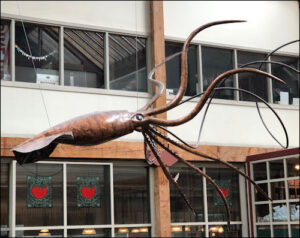 This giant squid hangs from a ceiling of Seattle’s Pike Place Market. There’s no great social significance to this piece, yet it is visually arresting and amusing to behold. This falls in the whimsical category.
This giant squid hangs from a ceiling of Seattle’s Pike Place Market. There’s no great social significance to this piece, yet it is visually arresting and amusing to behold. This falls in the whimsical category.
This outdoor ornamentation with an orange falling man appears outside a commercial establishment in Victoria, the capital of British Columbia. The piece does not memorialize anything, but it is colorful and a delight to the eye. I would classify this also as whimsical.
 I stumbled across this statuary in downtown Atlanta outside a Mellow Mushroom pizza restaurant. The funny little man standing under the mushroom is holding a saxophone. This light-hearted piece serves its commercial function well, inviting passersby into the restaurant.
I stumbled across this statuary in downtown Atlanta outside a Mellow Mushroom pizza restaurant. The funny little man standing under the mushroom is holding a saxophone. This light-hearted piece serves its commercial function well, inviting passersby into the restaurant.
 These giant flowers stand in a public space near the Seattle Space Needle. They are bright and colorful during the daytime and, powered by solar panels, they apparently glow at night. Though gigantic, the scale of these flowers is appropriate to the venue, Seattle Center, with its enormous museums and other public buildings. This is not great art for the ages, but it is whimsical and adds to the fun.
These giant flowers stand in a public space near the Seattle Space Needle. They are bright and colorful during the daytime and, powered by solar panels, they apparently glow at night. Though gigantic, the scale of these flowers is appropriate to the venue, Seattle Center, with its enormous museums and other public buildings. This is not great art for the ages, but it is whimsical and adds to the fun.
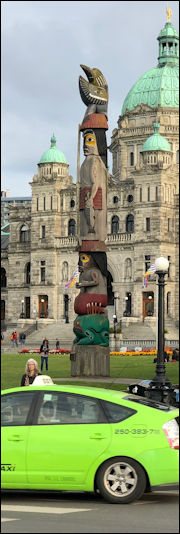 This totem pole is displayed in front of the British Columbia parliament building in Victoria. From an artistic perspective, this isn’t the greatest totem pole I saw — there were better pieces in the Sitka, Alaska. Still, the indigenous form of artwork is entirely appropriate for a city where local tribes maintained a vibrant presence before the Europeans arrived. Totem poles are carved from tree trunks, which sets severe constraints within which the wood carver must work. I can’t speak for this particular piece, but the Sitka totem polls were highly stylized — ravens, eagles, bears, and wolves, with arms, legs, wings, beaks and snouts all fitting within the circumference of the pole. Moreover, the totems are imbued with mythological significance. Totem poles make marvelous public art.
This totem pole is displayed in front of the British Columbia parliament building in Victoria. From an artistic perspective, this isn’t the greatest totem pole I saw — there were better pieces in the Sitka, Alaska. Still, the indigenous form of artwork is entirely appropriate for a city where local tribes maintained a vibrant presence before the Europeans arrived. Totem poles are carved from tree trunks, which sets severe constraints within which the wood carver must work. I can’t speak for this particular piece, but the Sitka totem polls were highly stylized — ravens, eagles, bears, and wolves, with arms, legs, wings, beaks and snouts all fitting within the circumference of the pole. Moreover, the totems are imbued with mythological significance. Totem poles make marvelous public art.
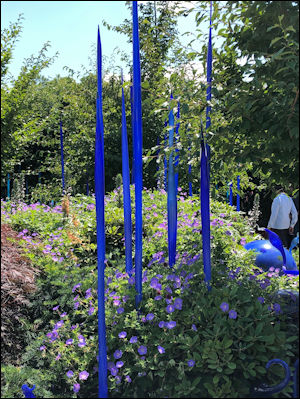 I don’t know if these blue tubes fully qualify as public art — they appear in Seattle’s Chiluly Garden and Glass museum, which charges admittance. Regardless, the display of these and dozens of other glassworks are brilliantly creative. I’ve never seen brightly colored glass integrated with brightly colored flowers, as the Chiluly Garden does. It makes me want to go out any buy some glasswork for my little patio garden.
I don’t know if these blue tubes fully qualify as public art — they appear in Seattle’s Chiluly Garden and Glass museum, which charges admittance. Regardless, the display of these and dozens of other glassworks are brilliantly creative. I’ve never seen brightly colored glass integrated with brightly colored flowers, as the Chiluly Garden does. It makes me want to go out any buy some glasswork for my little patio garden.
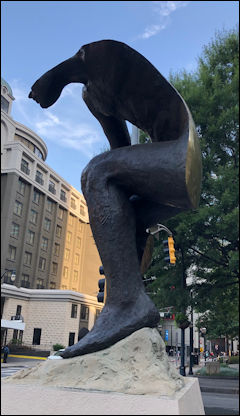 Now we move into the realm of concept art. This statue, entitled “Emergent,” is located in downtown Atlanta. It shows a partially formed human body. I suppose it is blandly interesting to view the statue from different perspectives, but the piece doesn’t do much for me. I’d classify it as so-so art — momentarily diverting, but not something that moves or delights me.
Now we move into the realm of concept art. This statue, entitled “Emergent,” is located in downtown Atlanta. It shows a partially formed human body. I suppose it is blandly interesting to view the statue from different perspectives, but the piece doesn’t do much for me. I’d classify it as so-so art — momentarily diverting, but not something that moves or delights me.
 Moving down the scale from worthwhile to worthless, I present for your viewing pleasure this gargantuan abstract steel structure located in Seattle’s Olympic Sculpture Park. The only redeeming virtue of this piece is the way the shape assumes radically different appearances depending on the perspective from which it is viewed. OK, I guess that’s kind of cool. But I’m thinking that the park foundation was just trying to fill space.
Moving down the scale from worthwhile to worthless, I present for your viewing pleasure this gargantuan abstract steel structure located in Seattle’s Olympic Sculpture Park. The only redeeming virtue of this piece is the way the shape assumes radically different appearances depending on the perspective from which it is viewed. OK, I guess that’s kind of cool. But I’m thinking that the park foundation was just trying to fill space.
Then there’s this…
This monstrosity also resides at the Olympic Sculpture Park. I initially passed by, mistaking it for a utility structure. Then I did a double take when I saw the sign, which said, “Please do not touch. Touching can harm the art.”
Seriously, this is art?
Really, touching can harm it?
To me, this “sculpture” looks like giant slab of iron. It conveys no emotion, it celebrates nothing, it delights none of the senses, and it inspires not the slightest sense of joy or or awe or whimsy. Anyone skilled at welding could have made it. I’d rather contemplate a rock. At least a rock has variations of texture and color. I can’t believe someone paid money for this monolith. I’d pay money to have it removed.
Bacon’s bottom line: Virginia could benefit from more public art — good public art. These examples convey a sense of what’s possible, both the good and the bad.


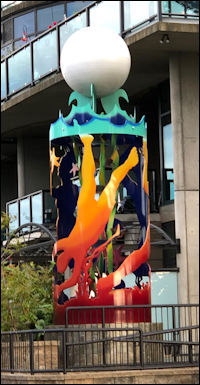

Leave a Reply
You must be logged in to post a comment.